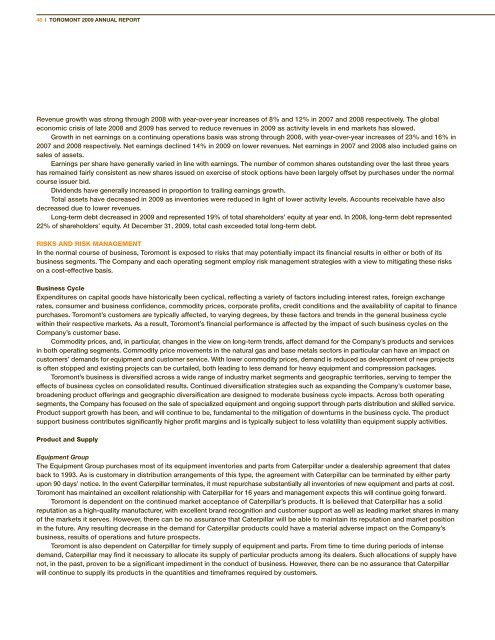2009 Annual Report - Toromont Industries Ltd.
2009 Annual Report - Toromont Industries Ltd.
2009 Annual Report - Toromont Industries Ltd.
Create successful ePaper yourself
Turn your PDF publications into a flip-book with our unique Google optimized e-Paper software.
46 | TOROMONT <strong>2009</strong> ANNUAL REPORT<br />
Revenue growth was strong through 2008 with year-over-year increases of 8% and 12% in 2007 and 2008 respectively. The global<br />
economic crisis of late 2008 and <strong>2009</strong> has served to reduce revenues in <strong>2009</strong> as activity levels in end markets has slowed.<br />
Growth in net earnings on a continuing operations basis was strong through 2008, with year-over-year increases of 23% and 16% in<br />
2007 and 2008 respectively. Net earnings declined 14% in <strong>2009</strong> on lower revenues. Net earnings in 2007 and 2008 also included gains on<br />
sales of assets.<br />
Earnings per share have generally varied in line with earnings. The number of common shares outstanding over the last three years<br />
has remained fairly consistent as new shares issued on exercise of stock options have been largely offset by purchases under the normal<br />
course issuer bid.<br />
Dividends have generally increased in proportion to trailing earnings growth.<br />
Total assets have decreased in <strong>2009</strong> as inventories were reduced in light of lower activity levels. Accounts receivable have also<br />
decreased due to lower revenues.<br />
Long-term debt decreased in <strong>2009</strong> and represented 19% of total shareholders’ equity at year end. In 2008, long-term debt represented<br />
22% of shareholders’ equity. At December 31, <strong>2009</strong>, total cash exceeded total long-term debt.<br />
RISKS AND RISK MANAGEMENT<br />
In the normal course of business, <strong>Toromont</strong> is exposed to risks that may potentially impact its financial results in either or both of its<br />
business segments. The Company and each operating segment employ risk management strategies with a view to mitigating these risks<br />
on a cost-effective basis.<br />
Business Cycle<br />
Expenditures on capital goods have historically been cyclical, reflecting a variety of factors including interest rates, foreign exchange<br />
rates, consumer and business confidence, commodity prices, corporate profits, credit conditions and the availability of capital to finance<br />
purchases. <strong>Toromont</strong>’s customers are typically affected, to varying degrees, by these factors and trends in the general business cycle<br />
within their respective markets. As a result, <strong>Toromont</strong>’s financial performance is affected by the impact of such business cycles on the<br />
Company’s customer base.<br />
Commodity prices, and, in particular, changes in the view on long-term trends, affect demand for the Company’s products and services<br />
in both operating segments. Commodity price movements in the natural gas and base metals sectors in particular can have an impact on<br />
customers’ demands for equipment and customer service. With lower commodity prices, demand is reduced as development of new projects<br />
is often stopped and existing projects can be curtailed, both leading to less demand for heavy equipment and compression packages.<br />
<strong>Toromont</strong>’s business is diversified across a wide range of industry market segments and geographic territories, serving to temper the<br />
effects of business cycles on consolidated results. Continued diversification strategies such as expanding the Company’s customer base,<br />
broadening product offerings and geographic diversification are designed to moderate business cycle impacts. Across both operating<br />
segments, the Company has focused on the sale of specialized equipment and ongoing support through parts distribution and skilled service.<br />
Product support growth has been, and will continue to be, fundamental to the mitigation of downturns in the business cycle. The product<br />
support business contributes significantly higher profit margins and is typically subject to less volatility than equipment supply activities.<br />
Product and Supply<br />
Equipment Group<br />
The Equipment Group purchases most of its equipment inventories and parts from Caterpillar under a dealership agreement that dates<br />
back to 1993. As is customary in distribution arrangements of this type, the agreement with Caterpillar can be terminated by either party<br />
upon 90 days’ notice. In the event Caterpillar terminates, it must repurchase substantially all inventories of new equipment and parts at cost.<br />
<strong>Toromont</strong> has maintained an excellent relationship with Caterpillar for 16 years and management expects this will continue going forward.<br />
<strong>Toromont</strong> is dependent on the continued market acceptance of Caterpillar’s products. It is believed that Caterpillar has a solid<br />
reputation as a high-quality manufacturer, with excellent brand recognition and customer support as well as leading market shares in many<br />
of the markets it serves. However, there can be no assurance that Caterpillar will be able to maintain its reputation and market position<br />
in the future. Any resulting decrease in the demand for Caterpillar products could have a material adverse impact on the Company’s<br />
business, results of operations and future prospects.<br />
<strong>Toromont</strong> is also dependent on Caterpillar for timely supply of equipment and parts. From time to time during periods of intense<br />
demand, Caterpillar may find it necessary to allocate its supply of particular products among its dealers. Such allocations of supply have<br />
not, in the past, proven to be a significant impediment in the conduct of business. However, there can be no assurance that Caterpillar<br />
will continue to supply its products in the quantities and timeframes required by customers.




